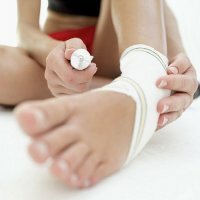Intervertebral hernia of the lumbar spine
In addition, the intervertebral hernia of the lumbar spine can develop against the backdrop of pathologies of the endocrine system, chronic inflammatory processes, intoxication and certain genetic diseases.
Separately, there are other provocative factors:
-
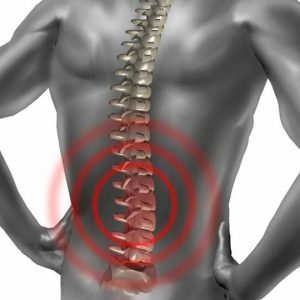 age 30-50 years: it is during this period that people most often fall into accidents, raise the severity and receive industrial and domestic injuries;
age 30-50 years: it is during this period that people most often fall into accidents, raise the severity and receive industrial and domestic injuries; - smoking: first a violation of the saturation of blood with oxygen, then this problem goes to the intervertebral disks;
- male gender: according to statistics, it is men who most often suffer from the disease under consideration;
- heavy physical work: the intervertebral disks just do not have time to get nutrients, because there is a constant load on them.The most dangerous are monotonous movements, coupled with the rise of heavy weights;
- excess weight: the spine is heavily loaded, and suffers mainly from the lumbar region;
- inactive mode of life: if the volume of movements is insufficient, the intervertebral discs do not receive the necessary nutrition;
- minor injuries: even a simple dip on slippery stairs can result in intervertebral hernia, this can happen in a few years.
Symptoms of the intervertebral hernia of the lumbar spine
It should be immediately warned: the signs of the disease in question are not unique, they can be inherent in other pathologies.Therefore, even if some signs of development of the intervertebral hernia of the lumbar spine have a place to be, do not panic.It is advisable to visit a doctor and undergo a complete examination to make sure the presence of the pathology in question, or in its absence.
Pain syndrome
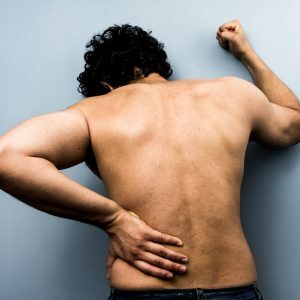 Most often present on the inner side of the thigh, then spreads to the knee, shin and inner part of the ankle.Some patients complain that the pain irradiates( "gives") to the buttock or foot of the foot, or is localized at some particular point of the waist.
Most often present on the inner side of the thigh, then spreads to the knee, shin and inner part of the ankle.Some patients complain that the pain irradiates( "gives") to the buttock or foot of the foot, or is localized at some particular point of the waist.
The pain, as the disease develops, changes its localization - it "descends" to the lower leg, heel and back of the foot.At the initial stages is of a non-permanent nature and can be in the form of a lumbago and a drawing unpleasant sensation.
Pain syndrome increases with prolonged standing, prolonged walking, sharp turning or tilting of the trunk, driving along the road with irregularities.But to ease the pain in the initial stages can be by taking a recumbent position.
Weakening of the muscles of the lower extremity
It becomes difficult for the patient to crouch, bounce, climb the stairs - the leg very quickly gets tired.If the hernia is already squeezing the spinal cord, the described signs will be characteristic for both lower limbs.
Note: if there is compression of the spinal cord, then the banal weakness of the muscles of the lower limbs, without proper treatment, can result in paralyzing the legs.
Motion limitation
The muscles become weak and the patient will note some limited movements.For example, he can not perform deep inclinations forward and to the side, raise his leg bent at the knee.
Sensitivity disorder
In the lower extremities and in the lumbar region of the spine there will be numbness, burning, tingling, or a feeling of freezing.However, the pain or exposure to too hot / cold temperatures is not felt in full.
Skin changes on the affected leg
The aching leg is pale, it has less hair, there may be increased or, conversely, decreased sweating, the skin on the affected leg is cold to the touch.
Note: The pulse on the affected leg will be probed at all places - under the knee, on the thigh, between the thumb and forefinger on the foot.
Dysfunctionality of pelvic organs
This syndrome is characteristic only in the case of squeezing the hernia of the spinal cord.Pathological changes on the part of the intestine are constipation or diarrhea, but there is no abdominal pain or flatulence.
In the case of a violation of the nervous regulation of the bladder, too frequent urge to urinate, and in rare cases - urinary incontinence.
The sexual desire is reduced, men get erectile dysfunction and develop chronic prostatitis( inflammation of the prostate gland), and in women - gynecological diseases.
In addition to the listed symptoms, it is possible to reveal the intervertebral hernia of the lumbar spine according to the signs that will be visible to the relatives and friends:
- the patient hunches and slouches;
- one leg is visually perceived shorter than the other;
- patient's movements become unstable;
- on the bare back you can see strained muscles on one side of the spinal column;
- the posture of the patient changes dramatically.
Treatment of intervertebral hernia of the lumbar spine
Therapy in this disease is primarily aimed at eliminating pain and eliminating spasm of the clamped muscles of the spine, eliminating ischemia of the spinal cord and its roots.In addition, there is a need to create a muscular corset, balancing the joints between the processes of the vertebrae.
Treatment of the intervertebral hernia of the lumbar spine is divided into three periods:
- Acute.The patient complains of intense pain, stiffness of movements and a violation of sensitivity on the lower limbs.
- Subacute.It begins in 3-5 days and is characterized by a decrease in the severity of the pain syndrome, but sensitivity during this period is only partially restored.
- Restore.This period begins 3-4 weeks after the start of treatment.Characteristic for him will be the absence of pain, and only a slight violation of sensitivity.
This division is necessary in order for the physician to be able to apply the
to select the right therapy tactics.In an acute period, exclusively conservative therapy is used, but in the subacute and recovery period, surgical intervention can also be used.
Conservative treatment
Acute period
The patient is shown bed rest, minimal motor activity.The patient should lie on a small pillow, strictly on the back, and under the loin should be placed a cotton-gauze roll.
Please note: the right position of the patient should be given by his attending physician.The specialist knows exactly which area of the disc there is a gap, the patient's position will depend on this - for example, if neuralgia of the sciatic nerve is present, the legs should be bent in the hip and knee joints.
Medications used in the treatment of an acute period of the disease in question:
- Anesthetics that have both anti-inflammatory and anti-inflammatory effects.Diclofenac, Movalis, and Rofika are prescribed as injections in the first 3-5 days of treatment.Then the injections are gradually replaced with tablets with a similar effect - Ibuprofen, Meloksikam and others.
- Blockade with novocaine.It is carried out with the addition of an anti-inflammatory hormone, so that the pain disappears immediately and for a period of 2-3 weeks.
- Drugs that can relieve painful muscle spasm.The muscle relaxants of the central action - Miodocalm or Sirdalud are used.
- Vitaminotherapy.Appoint vitamins B6, B1, B12 in the complex - drugs Neurovitan, Milgamma or Neurobeks.
Subacute period
The patient should be in a semi-posture mode, in the framework of drug therapy, analgesic and anti-inflammatory drugs in tablets, vitamins and muscle relaxants in tablets are prescribed. In the subacute period, physiotherapy can be performed:
-
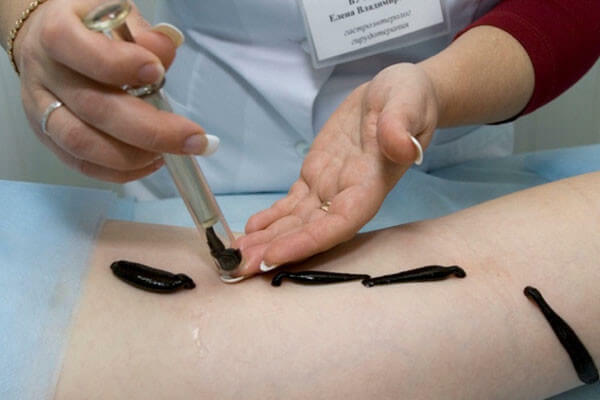 acupressure;
acupressure; - acupuncture;
- underwater massage;
- thermal procedures;
- electrophoresis with anti-inflammatory drugs;
- diadynamic therapy.
In this period of treatment of the intervertebral hernia of the lumbar spine, the use of medical leeches has proved to be very effective - hirudotherapy is carried out with a course of 10-12 procedures with an interval of 4 days.But the massage should be carried out with extreme caution, if the patient complains of pain in the lower extremities, then this method of treatment is contraindicated.There is another method of additional treatment in the subacute period of the disease under consideration: post-isometric relaxation, which is conducted only with a specialist.The procedure concludes in a combination of ten-second work of muscles( tension / tension, but without pain) and the same maximum relaxation time.
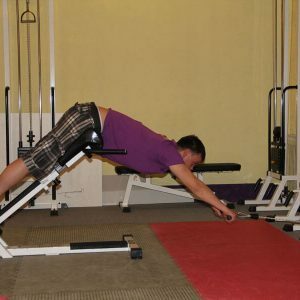 Note: exercise therapy in the subacute period is considered the main method of treatment.But classes should be conducted only on the prescription of a doctor and under the supervision of a specialist.In no case it is impossible to perform exercises for pain in the legs or lower back, and the optimal option is the use of a discharge corset during exercise.
Note: exercise therapy in the subacute period is considered the main method of treatment.But classes should be conducted only on the prescription of a doctor and under the supervision of a specialist.In no case it is impossible to perform exercises for pain in the legs or lower back, and the optimal option is the use of a discharge corset during exercise.
Recovery period
Drug treatment at this stage of conservative therapy is extremely limited - painkillers are used only in case of resumption of pain, for example, when performing exercises within the framework of therapeutic physical training or massage.
It is very important in the recovery period to regularly engage in exercise therapy under the guidance of a specialist.Moreover, the number of exercises increases, they become diverse and designed to fulfill the task of restoring muscle tone, strengthening them.The physiotherapist will pick up exercises with gymnastic objects -
Deletion of the intervertebral hernia of the lumbar spine
The decision to remove the hernia of the lumbar spine is taken only with certain indications:
-
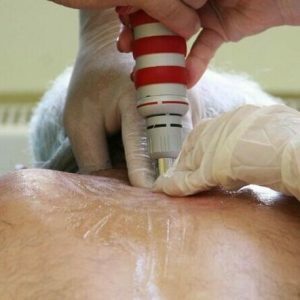 spinal column narrowing;
spinal column narrowing; - numbness of the lower extremities and muscle weakness progress, despite the fact that a competent therapeutic treatment is performed;
- progresses in violation of pelvic organs;
- with a repeated "outbreak" of the disease in the same spine after a seeming recovery;
- part of the hernia emerged into the vertebral canal;
- the compression of the horse's tail occurred - the end of the spinal cord in the form of a bundle of nerves.
The essence of surgical intervention in the intervertebral hernia of the lumbar spine is the release of the spinal cord from the hernia.Such surgical intervention can be performed in different ways:
- endoscopic;
- percutaneous discectomy;
- with endoprosthetics of the disc;
- laser reconstruction.
Note: surgical treatment of the disease in question is the last decision that the attending physician can make.While conservative treatment gives positive results, the operation is not assigned.
Preventative measures
To prevent the development of a hernia in the lumbar spine, it is necessary to pay attention to the recommendations of doctors:
- should be self-weight control;
- power should be varied and full;
- it is necessary to lead an active lifestyle and prevent hypodynamia.
The intervertebral hernia of the lumbar spine is a disease that is extremely important to diagnose.If treatment is started at the neurologist on time, then within 5 days after pain relief, the patient can return to the habitual way of life.If you follow all the prescriptions and recommendations of the attending physician, then the symptoms of the disease in question may not recur.
Tsygankova Yana Aleksandrovna, medical reviewer, therapeutist of the highest qualification category



